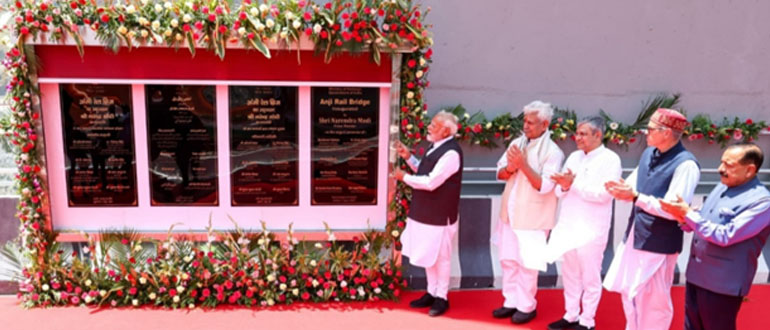Srinagar | WTNS | Agha Syed Amin Musvi | June 07:In a moment laden with symbolism and significance, Prime Minister Narendra Modi on Friday flagged off the first Vande Bharat Express between Shri Mata Vaishno Devi Katra and Srinagar, marking the culmination of decades of anticipation and engineering resolve. The occasion, set against the backdrop of the mighty Pir Panjal, also witnessed the formal inauguration of two monumental rail bridges — the Chenab and Anji — alongside the launch of infrastructure projects amounting to ₹46,000 crore.
The inauguration, held in Katra, was attended by J&K Lieutenant Governor Manoj Sinha, former Chief Minister Omar Abdullah, Union Ministers Ashwini Vaishnaw, V. Somanna, and Dr. Jitendra Singh, among others.
Engineering a Connection
The Udhampur-Srinagar-Baramulla Rail Line (USBRL), often described as the most challenging railway project undertaken in independent India, is now inching towards full operational status. With the addition of the Chenab Bridge — the world’s tallest railway arch standing at 359 metres above riverbed level — and the Anji Khad Bridge — the country’s first cable-stayed railway bridge — engineers have accomplished what was once deemed implausible.
“These structures are not just feats of engineering; they are symbols of national will and unity,” the Prime Minister said, calling them the new face of Jammu and Kashmir’s development story.
The Chenab Bridge, which surpasses the Eiffel Tower in height, is expected to emerge as both a vital link and a tourist magnet. The Anji Bridge, located in a region known for its seismic and topographical challenges, is poised to play a crucial role in stabilising rail connectivity across the valley.
A Symbolic Journey
For the people of Jammu and Kashmir, the operationalisation of rail connectivity is a culmination of long-standing aspirations. Speaking at the event, the Prime Minister recalled former CM Omar Abdullah’s remarks about waiting since his school days for the train to reach the valley. “Many generations have dreamt of this moment. Today, that dream stands fulfilled,” he said.
The Vande Bharat Express — India’s premium semi-high-speed train — will significantly reduce travel time between the valley and the plains, enhancing not just passenger movement but also the transport of goods. Officials said the improved logistics will provide a substantial boost to the regional economy, particularly benefitting Kashmir’s horticulture, handicrafts, and tourism sectors.
Bridging Development
While the rail link captured public imagination, it was part of a larger infrastructure narrative unveiled on Friday. Among the major projects launched were new medical colleges, highway upgrades, and rural road initiatives.
In Reasi, the foundation stone was laid for a new government medical college, part of efforts to decentralise healthcare in the Union Territory. Simultaneously, the Shri Mata Vaishno Devi Institute of Medical Excellence is being expanded to cater to growing patient inflows.
Other projects include the six-laning of the Kathua-Jammu highway, roads under the Vibrant Villages Programme, and over 1,800 km of new roads designed to link 400 remote habitations, many of them located along the sensitive border regions.
Human Stories Amid Steel and Stone
In his address, the Prime Minister also shared anecdotes from Sangaldan village, where residents — especially children — had previously only seen trains in videos. “Now, trains will pass through their backyards. Connectivity is not just about infrastructure; it is about dignity and opportunity,” he said.
The Chenab Rail Bridge was built by workers and engineers from across India. The Prime Minister later interacted with some of them, acknowledging their perseverance in difficult conditions, including high winds, sub-zero temperatures, and unstable terrain. “They are the unsung nation-builders,” Modi said in a social media post.
The Road Ahead
While the inauguration marks a milestone, experts suggest that operational sustainability, maintenance of such high-altitude infrastructure, and integration with local transportation systems will be the next challenges.
Nevertheless, the narrative of inclusion, connectivity, and confidence was palpable in Katra. Describing Jammu and Kashmir as the “Crown Jewel of Maa Bharati,” the Prime Minister asserted that the territory was now firmly on the path to economic rejuvenation and national integration.
“Whether in education, healthcare, or industry, J&K is emerging not as a distant frontier, but as a vibrant participant in India’s developmental journey,” he concluded.



